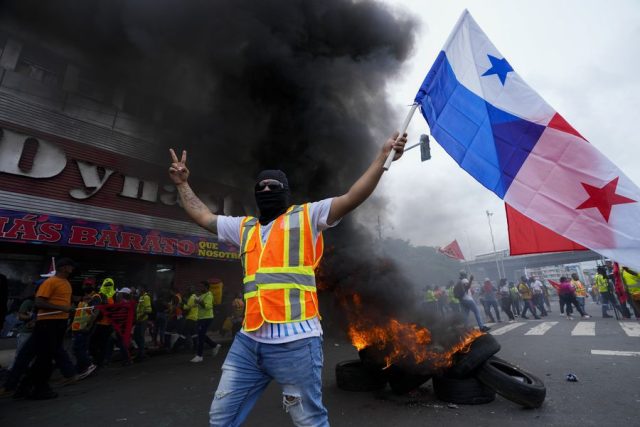Panama has three weeks of conflict between the unions and the Government. Although a negotiating table has already been set up, the protests in the streets continue and so does the repression.
The most visible consequence is that basic necessities have begun to be lacking in stores and videos of empty shelves raise alarms. Spokesmen such as the president of the Association of United Merchants of Merca Panama, Sebastián Oriel Peña, have asked the unions for «empathy» to prevent the situation from getting worse.
«Micro and small businesses, which are the engine of Panama, today see their economy affected and likewise the family economy of many workers who directly and indirectly work in this food distribution chain,» lamented Oriel Peña in statements to The Star of Panama.
In the same tone, different employers have demanded «awareness» from workers who have been on the streets for weeks to demand not only a drop in fuel prices, but also demands in salary, education, social and economic areas. How did the country that achieved one of the highest growth rates in the region last year, with 15.3%, fall into this situation?, asks the journalist Nazareth Balbás for RT.
Food insecurity
Local press reports emphasize the notable shortage of agricultural items, such as carrots, lettuce, potatoes and bananas in the main markets. The situation has not only caused the closure of shops, but also the loss of crops by producers.
Given this scenario, farm workers warn that the prices of food items could rise even more due to the lack of maintenance of the crops, the shortage of inputs for agriculture and the difficulties in transporting the crops.
«The national government must continue working in search of a transparent dialogue, with the participation of all the representative parties and establish mechanisms that guarantee that the commitments they adopt are viable, measurable and, most importantly, that they are fulfilled», Luis Frauca, the president of the Union of Industrialists of Panama, asserted yesterday.
According to Telemetro, meat, milk and vegetables have also begun to be lacking due to road closures, which resumed with greater force this week after the unions broke the commitment agreed with the Government to lift the blockades. For now, employers warn that the situation endangers the country’s food security.
However, the leaders of the protests assure that the Executive made them sign the agreement under pressure and showed no willingness to negotiate other demands, such as agreeing to lower the prices of the basic food basket and medicines. In addition, they were against the mechanism designed for the dispatch of fuel to people, which implies presenting the identity card.
Growth and inequality in Panama
In 2021, Panama was one of the countries with the highest economic growth after the slowdown caused by the covid-19 pandemic. With 15.3% expansion of the Gross Domestic Product (GDP), the Economic Commission for Latin America and the Caribbean (ECLAC) placed the Central American nation at the head of the recovery.
However, you have to read the small print of economic growth. In recent months, the sustained rise in fuel prices —enhanced by the conflict between Russia and Ukraine— revealed Panama’s model of energy dependency, which imports 100% of the oil derivatives it consumes.
There is not a single refinery in the country, which means that fluctuations in the international oil market have a strong direct impact on its economy. In fact, fuel supply is exclusively in private hands and the only thing the National Energy Secretariat (SNE) can do is set a price cap on fuel.
One of the key points of the agreement between the government and the unions was to establish a frozen fuel price of 3.25 dollars per gallon, which will take effect from July 18, in exchange for the lifting of the road blockades. However, the leaders of the protests have expanded their demands.
The underlying problem is that although Panama maintains a sustained rate of growth —beyond the downturn during the pandemic— it has structural problems that have worsened after the health crisis, such as inequality, fiscal opacity, corruption and high debt levels.
A country report prepared by the World Bank highlights that rural poverty «remained six times higher than in urban areas» and the covid-19 crisis caused an increase of 2.7 percentage points in the rate of poverty.
The situation is not new, since in 2015, an official report on income distribution revealed that 10% of the richest families in Panama owned 37.7 times more than the poorest, a situation that has not been reversed.
“In the case of Panama, growth has remained high in the context of the region, however, concentrated in productive sectors and specific provinces, which constitutes a structural factor of inequality. Therefore, it seems that it is not only about maintaining high growth, but also diversified and balanced territorially. Similarly, policies and productive investment are focused on the areas with the greatest comparative advantages in the country, which are generally sectors that are not labor-intensive, which has an impact on the concentration of income and, with this, the ability to influence decision-making”, states a report prepared by the Deputy Resident Representative of the UNDP in Panama, Aleida Ferreyra, and published last year.
Beyond the current situation, the Government of Laurentino Cortizo —which took office in July 2019— has several pending issues on the table and it is not only about negotiating with the unions to promptly lift the blockades, it is also urgent to give way to an agenda that addresses the inequalities and the historical problems that have been postponed time and time again.



